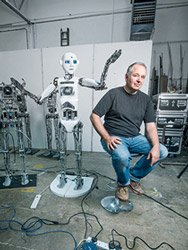
Posted to News on 25th Feb 2016, 12:46
Festo's fluidic valves help RoboThespian to act naturally
Festo has supplied its ultra-modern fluidic muscles and piezo valve technology to Engineered Arts Limited for use in the fourth generation of its "robot actor', RoboThespian.

RoboThespian is a life-sized humanoid robot designed for human interaction in a public setting. It is fully interactive, multilingual, and user-friendly, making it a useful device for communicating with and entertaining people. It currently greets visitors to NASA's Kennedy Space Center in Florida, provides information at the Phaeno Science Centre in Wolfsburg and interacts with visitors to Australia's National Science and Technology Centre, Questacon.
Standing 1.75m tall and weighing around 33kg, RoboThespian's chassis is made from aluminium, and its body shell from plastic. It is brought to life by a total of 30 motion axes, which are all controlled by an integrated computer, to make it move its head, arms and hands in a lifelike way. Finally, it interacts and communicates with the people it meets via a touchscreen and on-board sensors.
RoboThespian was invented and developed in the UK, by Engineered Arts Limited in Penryn, Cornwall, which is also where he is manufactured. Now in its fourth generation, its current form is the product of more than 10 years' continuous development. When looking for a technology that would make RoboThespian's movements seem as human as possible, the company turned to Festo for its expertise in pneumatics. Will Jackson, Director of Engineered Arts and inventor of the RoboThespian, says: "We use the fluidic muscle from Festo because it makes RoboThespian's movements appear very natural."
Bernd Lorenz, Head of Membrane Technologies at Festo explains: "The DMSP fluidic muscle is ideal for this application as it acts like a human muscle, it contracts and relaxes without friction resistance or breakaway torque, and is even stick-slip free. It is hermetically sealed and clean, as no lubricant is required. All movements, whether slow or quick, are jerk-free and perfectly smooth. With its flexible structure and its compliant behaviour it is the perfect drive for cooperation between man and machine."
RoboThespian's arms and hands are each moved by a total of two and eight fluidic muscles respectively (DMSP-10 and DMSP-20). The finger movements are executed by Festo's new, small DMSP-5. The fluidic muscle is a membrane-based actuator comprising of a flexible hose embedded with rhomboidal shaped multifilament yarns that mimics natural muscular movement. When internal pressure is applied, the hose expands in its peripheral direction, thus creating a tensile force and a contraction motion in the muscle's longitudinal direction. The usable tensile force is at its maximum at the start of the contraction and then decreases in a virtually linear manner as a function of stroke.
Lifelike movement
Lorenz says: "Activation via our VEAB piezo valves makes these properties even more apparent. And of course with the fluidic muscle, there is no need for any complex hydraulic or electrical constructions. These advantages are particularly critical in the area of animatronics, which is all about combining the most lifelike movement possible with appropriate communication. This is precisely what people expect when they encounter humanoid technology and interact with it."
Piezo valves are often a better alternative to conventional solenoid valves, especially in flow and pressure control. They are also well suited for directly controlled proportional valves, as used in the RoboThespian, because they are small, lightweight, precise, very durable, very fast and require up to 50 per cent less energy. Furthermore, they hardly generate any heat and work almost silently. These properties make them suitable for use in laboratory and medical technology automation.
Festo's fluidic muscle is suitable for a whole host of other applications. The pneumatic muscle has already proven and established itself in many application areas in industrial automation, for example as a pneumatic spring to control tensile stresses on belts, ropes, chains etc., and to regulate them sensitively; as a means of generating high clamping forces on a small diameter, for example when fixing components in moulds or machines; and for targeted shaking and fast vibration, as required in feeder and filling technology.
As for RoboThespian, it is a fascinating example of human-machine interaction. The project epitomises the future potential of Industry 4.0 in a most impressive style: humans create and program the machine, which then responds largely autonomously and flexibly to its environment.
For more information on Festo's fluidic valves, please visit www.festo.co.uk/fluidicmuscle.






























